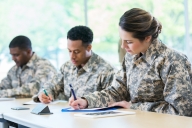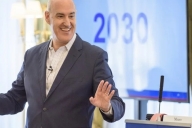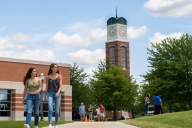You have /5 articles left.
Sign up for a free account or log in.
BOSTON -- With the ongoing influx of veterans onto campuses thanks to troop withdrawals from the Middle East and federal tuition benefits under the Post-9/11 GI Bill, more colleges than ever before are trying -- and in some cases, struggling -- to figure out the best ways to help that unique student population succeed. At a presentation here Friday at the annual meeting of the American College Health Association, the outgoing and incoming chairs of ACHA's veterans' group proposed a comprehensive approach through which programs think big but start small.
"Before we get to strategic thinking, we have to think bigger," said Brad J. Badgley, a senior health promotion specialist at Columbia University. "Based on that big-picture thinking, we can start to look at what we can actually do."
Individual health is affected by influences at multiple levels, Badgley said, so college officials should consider how they can help veterans at each one. The approach that Badgley proposed -- a socioecological one -- compels big-picture thinking because it takes both a population- and individual-based approach by addressing five different and increasingly broad areas: intrapersonal, interpersonal processes and primary groups, institutional factors, community and public policy.
"The socioecological model allows me to think about what the possibilities are and who can help me," said Badgley, who is also the outgoing chair of ACHA's Wellness Needs of Military Veteran Students Coalition. "Everybody's a part of this conversation, and they should be part of this conversation because we're trying to create a supportive environment for all students, including veterans."
After breaking into five groups, the student services staff and health officials in the room brainstormed ways to help veterans at each of the five levels. Some -- such as institutional factors -- had more obvious barriers and potential solutions than others. One problem at the institutional level is that counselors sometimes don't know how to help veterans -- but education and training could help address that.
"They experience anxiety themselves because they want to do the best they can for the veteran, but they may not be familiar with the military world," Badgley said. "And that's O.K." What's important is to set a positive tone, being inclusive and empowering veterans -- who aren't always eager to communicate or rely on others -- and recognizing that not all students are the same.
Only 22 percent of colleges with services for veterans (which by definition include active-duty students) provide transition assistance, the presenters said, citing research, and two out of five provide training opportunities for faculty and staff to better assist veterans with transitional issues. And while 33 percent of of colleges that serve veterans have staff trained to assist students with physical disabilities, only 22 percent have staff trained to assist with brain injuries.
Here are some of the ideas to come out of the session:
- Interpersonal Level
Veterans are often private about their histories and, being used to relying on only themselves and a very close-knit group, are hesitant to seek out help or services. Changing this attitude when it does exist -- conveying that it's O.K. to ask for assistance when it comes to their health -- would help, officials said. "My theory is that interventions need to be edgy," one official said, noting that caustic attitudes call for caustic interventions. Part of that is making sure veterans know these health services and support systems exist on campus, since these students often live off-campus and/or with families. And finally, once they show up, increasing confidence that they can succeed academically.
- Intrapersonal Processes and Primary Groups
Veteran-specific orientation programming was this group's first idea; having a close relationship between the registrar and veterans' services office can make registration and transition processes more smooth. During the academic year, health activities such as yoga and meditation can be the basis of informal support groups. And involving the students in tangential activities like suicide walks can get them engaged on campus and raise awareness of health issues. "It really plays to the culture of individuality," one official said; respecting their insular group dynamic when creating programming is key.
- Institutional Factors
The first step here is a needs assessment; universities can survey veterans to see what they lack and what they want. Reviewing and evaluating existing policies to make sure they're up-to-date and appropriate can resolve issues that might be flying under the radar; for example, conflicts in when students get their tuition grants from the Post-9/11 GI Bill and when their bill to the university is due. Allowing for early and extended registration (like athletes get) can help the process go smoother and mitigate work or family conflicts. And of course, cultural competency training for faculty and staff educates them on the issues veterans face and could increase support for those students. "Involving veterans in all processes at all levels for this is critical," one official said.
- Community Factors
"Mostly, it's getting everybody on campus, everybody off campus interested in this," one attendee said. Making sure different organizations have a relationship to or even physical space inside veterans' services or a military office keeps visibility high and accessibility easy. Especially for programs like ROTC, which already has so many resources in common with the veterans or military office, a close connection makes sense.
- Public Policy
National surveys that any campus can use could help gauge needs and veteran population projections. Working closely with the local Veterans' Affairs office and reaching out to local community representatives can raise awareness. Including student health insurance as part of VA benefits could help ensure veterans have adequate health services. Finally -- overlapping with institutional policies -- better and more time for registration could help veterans balance work and school.
"We should aspire to great things, but with the resources, let's be realistic with what the expectations are," Badgley said.
But this approach to creating veterans' services is about finding help in seemingly unusual places, and that goes for funding, too. Lorri Castro-Zenoni, the incoming coalition chair and director of health and wellness services at Salt Lake Community College, mentioned one campus she knows of that dedicates some of its sexual health dollars to veterans' programming, because those students need to be educated on those issues, too.
"When we think outside of the box, really there is no limit to where we can think when we're working with our students," Castro-Zenoni said.
"This is all part of this broad approach," Badgley said. "I'm hoping that people are thinking about things in a different lens that they maybe didn't think about before."








